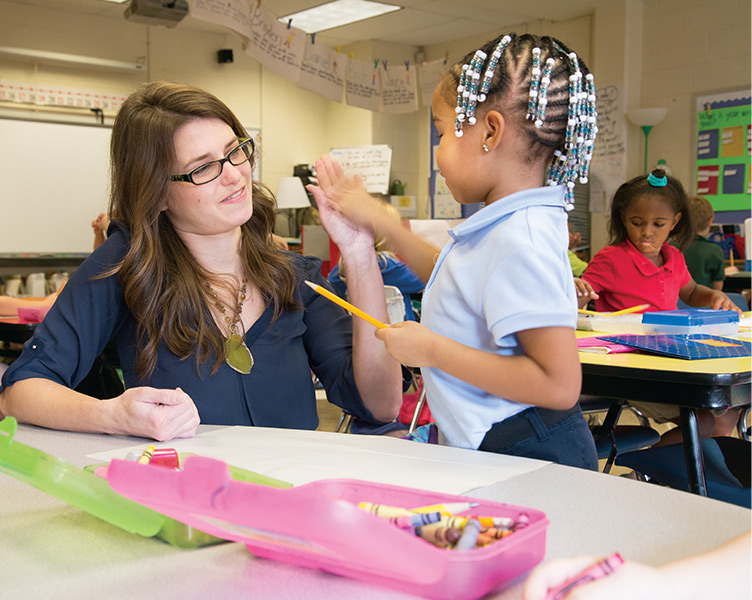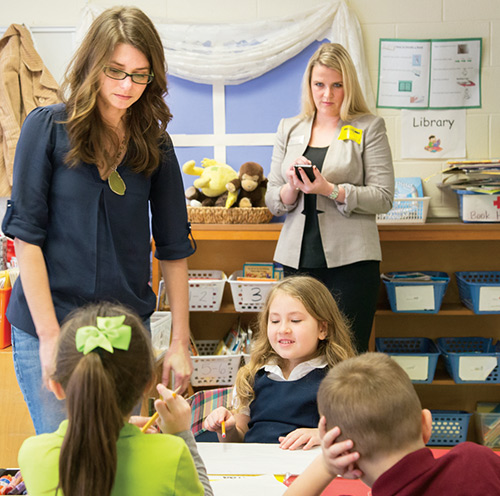All teachers have their own style of delivering instruction and leading a classroom. Some direct the class and are actively involved in lessons. Others believe in empowering students to form their own ideas and skills.
So which teaching practices are the most effective? As the teacher from “Ferris Bueller’s Day Off” might ask, “Anyone, anyone?” Researchers at UofL’s College of Education and Human Development (CEHD) have spent much of the last decade collecting evidence that answers this question. Specifically, they found that teachers who afford students frequent opportunities to engage with instruction are more successful at raising achievement.
The findings came in a study conducted over a period of more than seven years and involving more than 7,000 classroom observations. The study is part of the CEHD’s Academic and Behavioral Response to Intervention (ABRI) project to increase student achievement through changes in instruction and classroom management. The goal of the research was to evaluate the effectiveness of the project. The study was supported by federal grant funds that flowed through the Kentucky Department of Education to CEHD.
Laying the Groundwork for the study: before CEHD researchers began their study, they reviewed existing scientific literature on teaching and learning. They discovered increasing arguments in favor of teachers assuming more of a facilitator role to support students in constructing their own knowledge. This idea conflicts with the findings of the ABRI study, as well as many of the conclusions of educational science, which indicate that student achievement, problem-solving ability and self-esteem are highest when teachers present content to students and guide them through learning. This more direct method of teaching was found by the CEHD to be most effective with novice learners and those with a history of failure.
Observing teachers in the classroom: to conduct the study, CEHD researchers and their assistants sat in classrooms in more than 50 schools, mostly in Kentucky. The database also includes a small set of observations from schools in Virginia and other locations around the world where the CEHD has been invited to provide assistance. Observations were made in public elementary, middle and high school classrooms, representing a full spectrum of race, ethnicity and economic backgrounds.
With the goal of finding a cause-and-effect link between specific actions of teachers and student outcomes, CEHD researchers developed a coding system that allowed them to track observations on a handheld device. Every teacher behavior was assigned a code, along with reactions by students in response to those behaviors. For each tracking session, which lasted about 15 minutes, researchers picked a student at random to observe.
In particular, CEHD researchers looked at how many times teachers gave students an opportunity to respond to instruction. The teacher might say to a student, “Write that down.” Or, they might ask, “Can you share your thoughts on the story?” Any prompt by the teacher that invited students to participate in the lesson, through words or even a simple gesture, was considered an opportunity to respond.
Analysis of the study’s findings: As CEHD researchers performed an analysis based on their database of observations, they found some interesting correlations.
In one case, they took the data from 11 highachieving elementary schools in Kentucky with a Title I classification (high poverty) and matched that data with a sample of Title I schools that had the lowest scores in the state. The only significant difference between these schools was the amount of engagement prompted by the teacher. The average student in the high-achieving school had approximately 250 more opportunities to respond per week than the average student in low-achieving schools.
Effective Instruction Leads to a more level learning field
While there are many factors outside the classroom that impede student learning, such as family stress, the CEHD findings indicate that effective teaching can compensate for these obstacles.
The CEHD study supports the idea that teacherdirected instruction with high opportunities to respond is the most effective approach. In other words, the most successful teachers are those who explicitly defi ne learning concepts and goals, while actively engaging with students to confi rm their understanding. This strategy also involves providing positive feedback to students.
Students of all ages benefit from positive engagement
The CEHD study also showed that middle and high school teachers, on average, gave students fewer opportunities to respond than did elementary school teachers.
The assumption can be made that by the time students reach later grades, they can benefi t from self-directed and independent learning. However, study results show that older students react favorably to high levels of teacher involvement and interaction. Achievement scores go up, and disruptive behavior decreases.
| Elementary Classrooms | High School Classrooms | |
| Percentage of classroom observations in which the target student was given no opportunity to respond |
45% |
64% |
Application of the study’s findings
The CEHD has converted the tracking program on their handheld devices into an iPad app called SCOA (Student/Classroom Observation and Analysis), available on iTunes. Teachers who make use of the app can observe one another, with the aim of increasing both student opportunities to respond and academic performance.
Schools can also work with the CEHD’s Project ABRI team upon request to facilitate implementation of teacher-led, direct instruction strategies that give students ample opportunities to respond. As part of Project ABRI, the CEHD has developed webinars and videos to support schools in their efforts to improve learning outcomes for students.
Conclusions
How many times should a teacher give a student an opportunity to respond in class? CEHD researchers can’t answer this question with certainty. They do know that the higher the rate of opportunities to respond during instruction, the greater the likelihood that the student will be engaged. According to the study, teachers can control how they engage with a student, which is the number one predictor of student achievement.



























